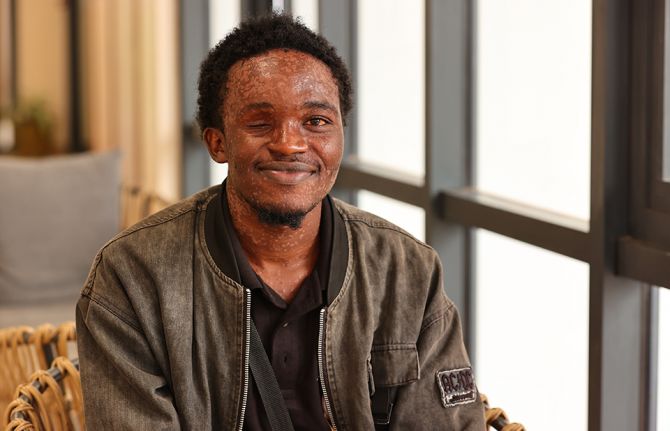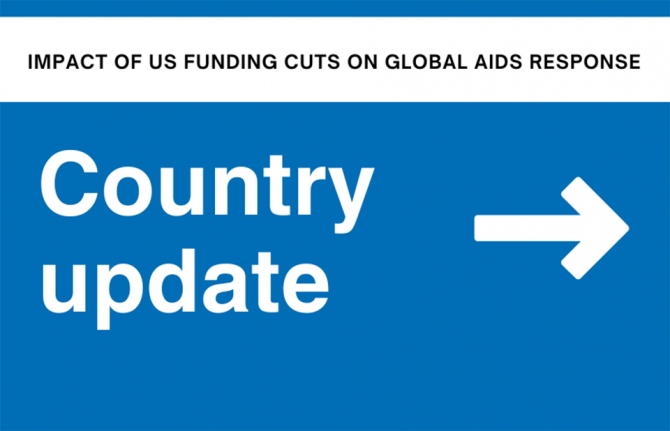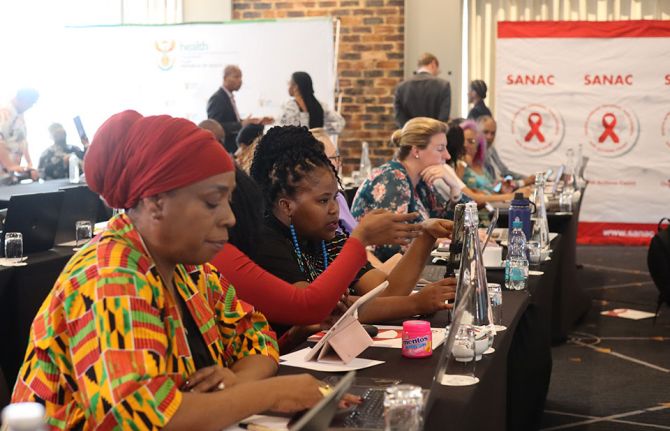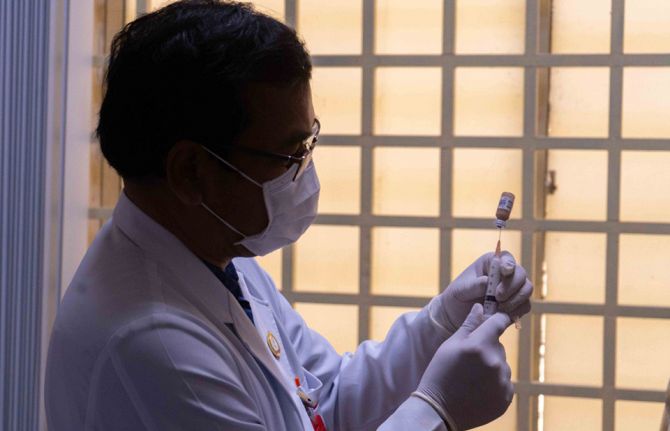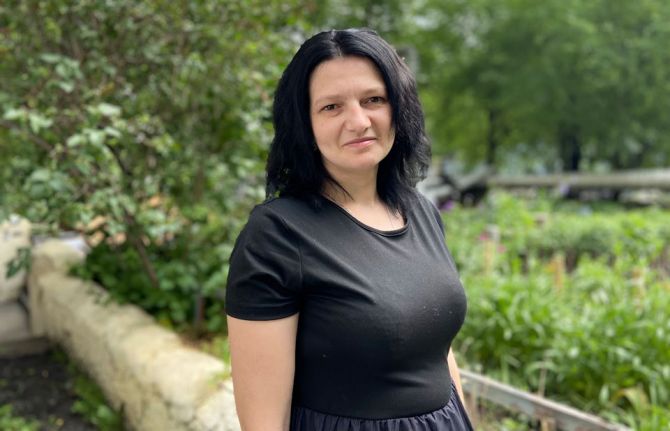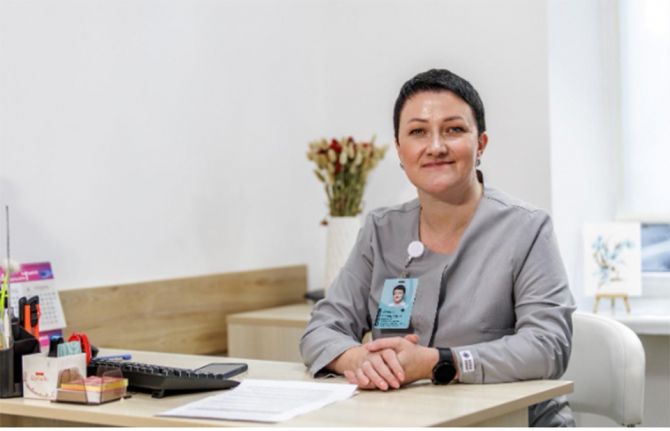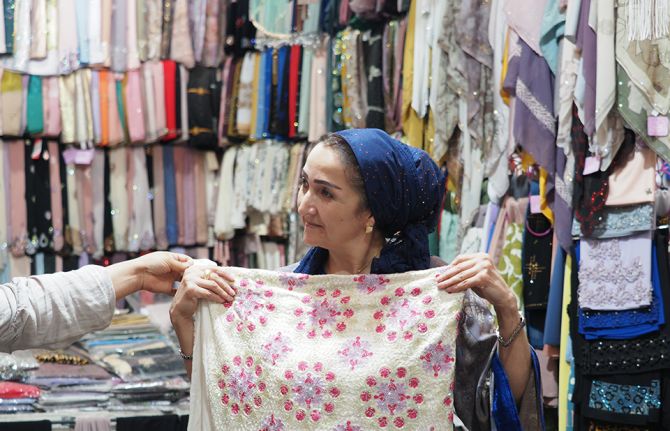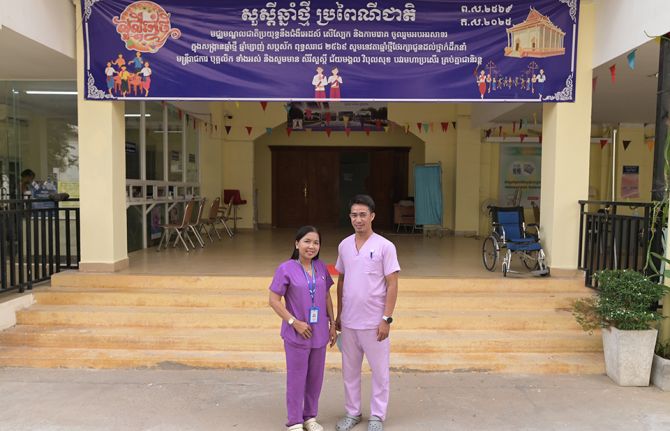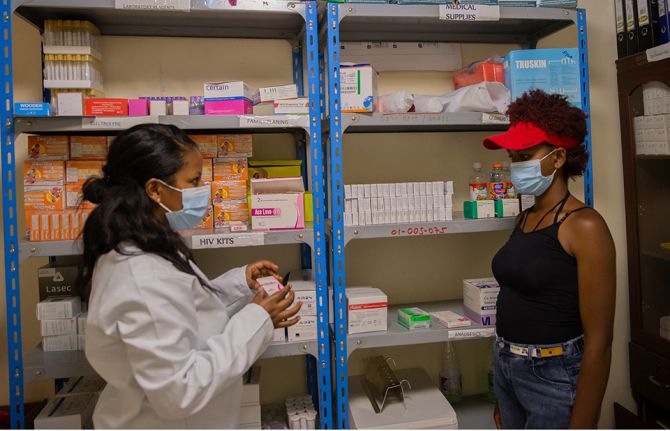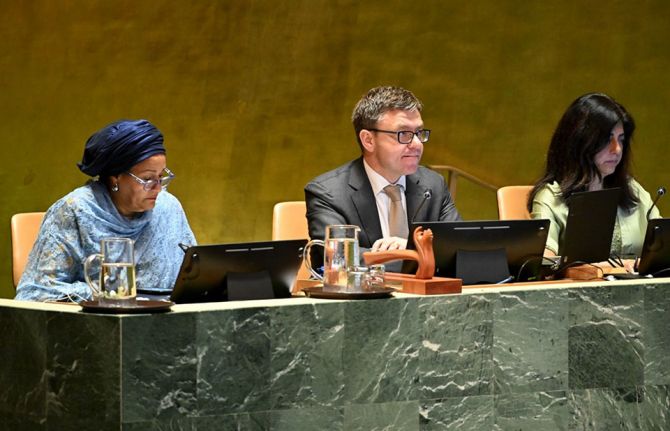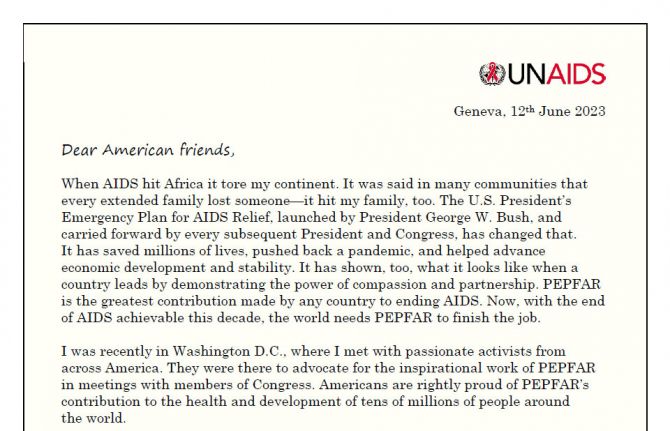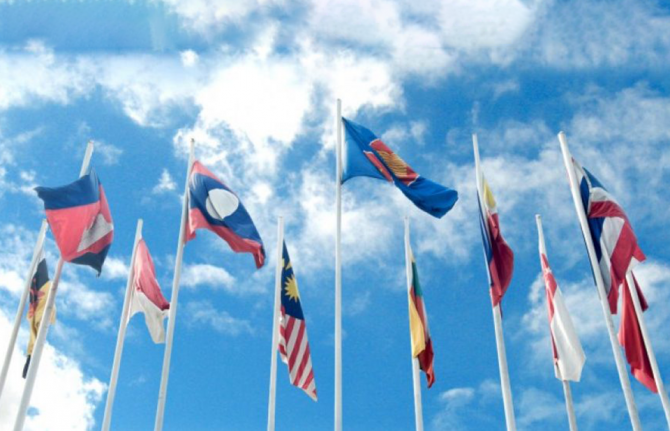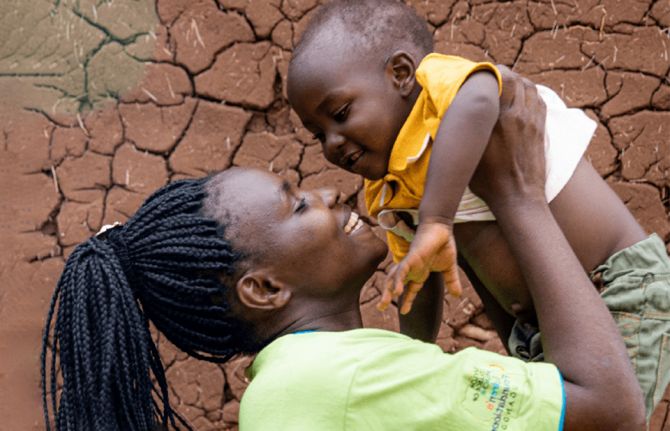
Feature Story
UNICEF Executive Director launches 'Facts for Life' in Lesotho
12 April 2010
12 April 2010 12 April 2010A version of the story was first published at unicef.org
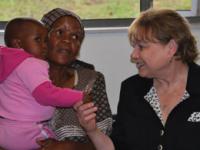
Ann M. Veneman visits clients at a children's clinical centre built by Baylor College of Medicine and Bristol-Myers Squibb in Maseru, Lesotho, where paediatric and family HIV care and treatment services are provided to young children and their caregivers.
During a recent visit to Lesotho, UNICEF Executive Director Ann M. Veneman launched Facts for Life, a publication that delivers life-saving information to families and communities on how to prevent child and maternal deaths, diseases, injuries and violence.
“Education is key”, said Ms Veneman. “Through simple messages, Facts for Life aims to bring vital knowledge to parents and caregivers, who are the first line of defence in protecting children from illness and harm.”
Circulated worldwide
Some 15 million copies Facts for Life have reached billions of people since its first publication in 1989. It is a co-publication by UNICEF, WHO, WFP, UNESCO, UNFPA, UNDP, UNAIDS and the World Bank, and provides practical advice on pregnancy, childbirth, major childhood illnesses, child development, early learning, parenting, protection, care and support for children.
New chapter on child protection
The publication includes a chapter on managing HIV. It promotes early diagnosis in children, effective treatment and anti retroviral therapy when prescribed. Currently most HIV-positive children are given such treatment after the age of five, when it might be too late. Without treatment, half of all babies born with HIV will die before their second birthday.
“One in ten children in Lesotho does not survive to see his/her fifth birthday, most as a result of AIDS and preventable causes like pneumonia and diarrhea, exacerbated by malnutrition” said Ms. Veneman, “Facts for Life can help bridge the information gap that contributes to the needless death of millions of young children.”
The publication also contains a new chapter on child protection, which provides information on keeping children safe from violent and harmful behaviours and practices.
“Girls and boys must be protected from violence and abuse,” said the Executive Director. “Protecting children so that they can grow up in safe environments and reach their full potential can help break the cycle of poverty.”
UNICEF Executive Director launches 'Facts for Lif
Cosponsors:
United Nations Children’s Fund (UNICEF)
World Health Organization (WHO)
World Food Programme (WFP)
United Nations Educational, Scientific and Cultural Organization (UNESCO)
United Nations Population Fund (UNFPA)
United Nations Development Programme (UNDP)
World Bank
Partners:
Unite for Children, Unite against AIDS
Feature stories:
Global Fund projects that UNAIDS’ call for elimination of mother–to-child HIV transmission by 2015 is within reach (08 March 2010)
Data shows progress needed on HIV testing and treatment for children and mothers (30 November 2009)
More infants protected from HIV as access to antiretroviral drugs to prevent mother-to-child transmission increases (30 September 2009)
Early diagnosis and treatment save babies from AIDS-related death (27 May 2009)
Contact:
Roshan Khadivi,
UNICEF New York
Tel + 1 212 326 7270, rkhadivi@unicef.org
Publications:
Facts for Life
Children and AIDS, Fourth Stocktaking Report, 2009 (pdf, 5.04 Mb.)
Children and AIDS, Fourth Stocktaking Report, 2009: Summary (pdf, 781 Kb.)
Related

Feature Story
New campaign to help prevent mother-to-child transmission of HIV in Lesotho
01 April 2010
01 April 2010 01 April 2010A version of this story was first published at unicef.org
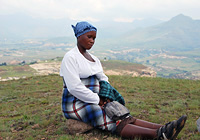
Malekena George heads home from the Pilot Health Clinic in Lesotho’s Berea district after her first antenatal check-up
Credit: © UNICEF Lesotho/2010
Malekena George, from Lesotho’s Berea district, is eight months pregnant, living with HIV, and exhausted from the five-hour trek she endured to get to the Pilot Health Clinic, for her first antenatal check-up. But because her journey to the clinic was so difficult, this visit may also be her last.
Ms. George's first child died at 13 months, and the Lesotho Ministry of Health is working to ensure that her second baby is not born with HIV.
In 2007, the Government, with help from UNICEF and other partners, initiated a massive effort to improve the country's Prevention of Mother-to-Child HIV Transmission (PMTCT) services. To succeed, they needed to ensure that every clinic in the country could provide HIV testing and treatment.
Lesotho leads the way
Lesotho became one of the first countries in the region to allow nurses to administer antiretroviral (ARV) treatments, which greatly expanded access to these critical interventions in the remote areas of the country where fewer doctors are available.
 Malekena George is given her new ‘Mother to Baby Pack’ at the Pilot Health Clinic. The pack includes ARV drugs and antibiotics
Malekena George is given her new ‘Mother to Baby Pack’ at the Pilot Health Clinic. The pack includes ARV drugs and antibiotics Credit: © UNICEF Lesotho/2010
But despite such efforts, major challenges remain, including the fact that many women, like Ms. George, are likely to make only one clinic visit.
This is a typical problem for many health systems in Africa. Though ARV drugs substantially increase the chances that a baby is born free of the virus, providing HIV-positive mothers with the treatment is not easy, especially in remote areas. The combination of distance, lack of transport and poverty prevents many women from making regular antenatal care visits. Such factors also lead many women to drop out of the PMTCT programmes, and to deliver their babies at home without the presence of trained medical professionals.
In a country such as Lesotho, where one in four people is living with HIV, that one antenatal visit has become all the more critical.
Keeping mother and child healthy
Innovative prevention methods are making a huge difference. The Lesotho Government has designed a minimum package for expectant mothers like Ms. George that includes the most effective ARV drugs and antibiotics needed to keep them, and their children, healthy. When they leave the clinic, women are also provided with clear instructions on what medicines they need to take – and when – and what medicines they need to give to their babies after birth.
In an effort to expand this public health innovation ever further, UNICEF and WHO have created a colour-coded take-home box that will be rolled out to five countries in eastern and southern Africa, Lesotho included, by July. Instead of the nurses having to pack all the medicines in small pill bags, this new 'Mother to Baby Pack' clearly separates the ARV drugs and the antibiotics according to when they need to be taken.
"We had to take advantage of the first antenatal visit," said UNICEF HIV and Maternal Health Expert Blandinah Motaung. "In case a woman delivers at home, she will have that package with her."
A dramatic drop in infections
With the new regimen of ARV treatments, and the efforts to facilitate women taking these medicines at home, health experts expect the number of babies born with HIV in Lesotho to drop dramatically.
"The expectation is that with better adherence to treatment and more focus on helping mothers to exclusively breastfeed for six months, we can further reduce the transmission rate to less than five per cent," said Ms. Motaung.
Take home medicine
After her check-up, Ms. George listened carefully to Marethabile Lelia, the clinic nurse, give instructions on the medicines that she would be carrying home. The mother-to-mother counsellor reiterated the importance of sticking to the treatment.
Although Ms. George has another appointment scheduled at the clinic, Ms. Lelia doesn't expect to see her until she returns with a six-week-old for the baby's first round of immunizations and first HIV test - children are again tested at 12, and then 18 months
As she prepared for her five-hour walk home, Ms. George clung to her medicines, understanding clearly that they represented her best hope of ensuring that her baby would escape HIV infection and grow up healthy
Lesotho has the third highest adult HIV prevalence in the world at 23.2%. There are an estimated 270,273 people living with HIV in Lesotho as of end 2007 of which 258,472 are adults and 11.801 children. At the end of 2007, an estimated 3,966 pregnant women with HIV received anti-retroviral treatment to prevent mother to child transmission (PMTCT) of HIV. The coverage of PMTCT programmes has increased from an estimated 5% in 2005 to 42% in the first quarter 2009
New campaign to help prevent mother-to-child tran
Cosponsors:
Partners:
Unite for Children, Unite against AIDS
Multimedia:
Watch video on the ‘Mother to baby pack’ initiative
Feature stories:
UNAIDS and Private sector meet to explore collaboration towards virtual elimination of mother-to-child transmission (16 March 2010)
Global Fund projects that UNAIDS’ call for elimination of mother–to-child HIV transmission by 2015 is within reach (08 March 2010)
Data shows progress needed on HIV testing and treatment for children and mothers (30 November 2009)
Partnering with faith based organizations for virtual elimination of mother to child transmission of HIV (14 October 2009)
More infants protected from HIV as access to antiretroviral drugs to prevent mother-to-child transmission increases (30 September 2009)
Early diagnosis and treatment save babies from AIDS-related death (27 May 2009)
Publications:
Children and AIDS, Fourth Stocktaking Report, 2009
Children and AIDS, Fourth Stocktaking Report, 2009 - Summary

Feature Story
UNICEF: Helping Ukraine’s most-at-risk young people
11 March 2010
11 March 2010 11 March 2010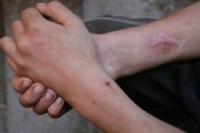
Credit: © UNICEF/UKRA01115/Pirozzi
UNICEF wants to help Ukraine’s many young injecting drug users protect themselves against HIV
Oksana is a teenage mother with a very young baby. She is also living on the streets of Kyiv, Ukraine’s capital. Having lost touch with her mother, who was sent to prison, she ran away from home to escape her abusive stepfather. She spends most of her day at the central railway station or the underground tunnels nearby but dreams of one day having a settled home for her son. These dreams are unlikely to be realised any time soon.
She is one of the many young people eking out a living on Ukraine’s streets who get no care and support. An unsafe social environment and high risk behaviour such as sex work and injecting drugs make young people living in the streets of Ukraine vulnerable to HIV. They are at the heart of an epidemic in the country worst affected by HIV in Europe and yet rarely have access to HIV prevention and treatment services.
One of the central aims of UNICEF in Ukraine is to try to help these most-at-risk young people, especially those who are homeless, to better protect themselves against HIV. Key activities include supporting outreach teams working with street children and adolescents, training social and health care workers and providing access to basic health services, education, training and housing.
According to the latest statistics, in 2006 more than 60% of injection drug users in Kyiv were living with HIV. In 2009, UNICEF conducted a study among street-based adolescents in several regions of Ukraine, which found high rates of drug use by injection, with two thirds of those having reported sharing needles. The study also revealed that one in ten male street adolescents had had sex with another male, often in exchange for money, clothes, or drugs.
Olena Sakovych is a UNICEF youth and adolescent development officer, who works closely with street children, as well as other most-at-risk adolescents. She is fully aware of the extent of the problem, with some young people initiating drug use by injection as early as age 13, and both boys and girls living on the streets often engaging in sex work at a similar age.
“These young people are the missing face of the HIV epidemic in Ukraine,” says Olena. “They need better care and more services. The situation here is critical. One of our main objectives at UNICEF is to make them visible to Ukraine’s political agenda and its AIDS response.”
The findings of the research informed the development of interventions and provision of health and social services to better address the needs of and help adolescents injecting drugs and engaging in sex work. In the city of Mykolyav, for example, outreach workers now recruit young female sex workers to a drop-in centre that offers a safe space, HIV counseling, and referrals to governmental health and social services centres, and non-governmental organizations that provide HIV prevention services, care and support.
Social workers accompany the women to those services, when necessary, which include gynaecological and infectious disease specialists, HIV treatment centres, and legal aid. Demand has far exceeded expectations. It was hoped that 50 under-aged sex workers would be recruited in the first six months. To date, well over a hundred adolescent girls have received services. A client satisfaction survey showed an increase in knowledge about HIV, as well as in motivation to seek help.
"UNICEF will continue to advocate for, and to support, country efforts to increase understanding of the epidemic and HIV prevention, protection, care and support services for most-at-risk adolescents,” says Susan Kasedde, UNICEF Senior Specialist on HIV Prevention among Adolescents. “In countries like Ukraine, until such services are made available, national epidemics cannot be stopped."
To this end, UNICEF promotes mobilization of governmental leadership; national and local political and community support; legislative and policy changes to enable wider access to HIV prevention and care services for most-at-risk adolescents, and strong partnership between the United Nations, government, civil society, young people themselves and people living with HIV.
“Ensuring that those most vulnerable to HIV infection like, young people on the streets, injecting drug users, those engaging in sex work, and men who have sex with men, have access to HIV prevention, treatment, care and support services is both a human right and a way to finally reverse the spread of the HIV epidemic,” says UNAIDS Country Coordinator Ani Shakarishvili. “Ukraine is continuing to make progress towards universal access but far more needs to be done. Strong political leadership and commitment will guarantee success. “
UNICEF: Helping Ukraine’s most-at-risk young peop
Cosponsors:
Partners:
Unite for Children, Unite against AIDS
Feature stories:
HIV prevention among most-at-risk young people: How to get the message across (28 December 2009)
Sexuality education an imperative for children and young people in a world affected by AIDS (10 December 2009)
More needs to be done to help young people most at risk of HIV infection (10 August 2009)
OPINION: HIV and drugs: two epidemics - one combined strategy (20 April 2009)
Injecting drug use and HIV: Interview with UNAIDS Team Leader, Prevention, Care and Support team (11 March 2009)
OPINION: Silence on harm reduction not an option (11 March 2009)
Publications:
Most-at-risk adolescents: the evidence base for strengthening the HIV response in Ukraine – Kyiv, 2009
Children and AIDS, Fourth Stocktaking Report, 2009
The State of the World’s Children
Related

Feature Story
Kenyan TV drama, ‘Shuga’, entertains as it raises AIDS awareness
08 February 2010
08 February 2010 08 February 2010A version of this story was first published at www.unicef.org
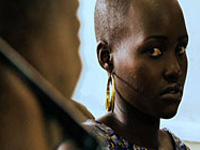
Actress Lupita Nyong'o in a scene from the Kenyan TV drama ‘Shuga’.
Credit: UNICEF
At its New York headquarters, UNICEF highlighted a recent collaboration with MTV through a screening of ‘Shuga’, a three-part TV drama about a group of young friends living in Nairobi, Kenya. As they explore the complexities of love, the characters confront the risk of HIV infection – and learn that a positive test result is not a death sentence.
MTV produced the programme in collaboration with UNICEF and other partners, including the US President’s Emergency Plan for AIDS Relief, or PEPFAR.
MTV has a long standing commitment to the AIDS response and has been partner of UNAIDS and its co-sponsors since 1996.
It’s fast, it’s furious, it’s cool – and that’s exactly how we filmed it.
Actress Lupita Nyong’o, who plays a lead role in ‘Shuga’ as Ayira.
Partnerships like this one play a vital role in UN’s efforts to halt and reverse the AIDS pandemic. When it comes to delivering messages about HIV prevention, working with media and entertainment partners such as MTV provides a valuable – and credible – connection to young audiences.
‘Meaningful engagement’
“It’s fast, it’s furious, it’s cool – and that’s exactly how we filmed it,” said actress Lupita Nyong’o, who plays a lead role in ‘Shuga’ as Ayira, a college student who finds herself torn between a boyfriend her own age and an older man. Ms. Nyong’o attended the screening and a panel discussion that followed, along with representatives of key partners in the project.

UNICEF collaborated with MTV to create ‘Shuga’, a TV drama set in Nairobi, Kenya. It includes messages about HIV prevention for young people.
Credit: UNICEF
The series shows how behaviours – including sexual involvement with multiple partners, sexual exploitation and alcohol abuse – can make young people more vulnerable to HIV.
During the panel discussion, PEPFAR Senior HIV/AIDS Prevention Advisor Tijuana A. James-Traore noted the programme’s power to speak effectively to young viewers.
“This is really what we mean when we talk about the meaningful engagement of young people in issues that impact their own lives,” she said. “No other person or persons, I think, could have communicated the messages in the way these young people have done.”
A regional priority
Messages about AIDS prevention are especially crucial in eastern and southern Africa, the heart of the global epidemic.

Lupita Nyong'o, a star of the Kenyan TV drama ‘Shuga’, attended a screening of the programme at UNICEF headquarters and took part in a panel discussion that followed.
Credit: UNICEF
“Young women in eastern and southern Africa are particularly severely affected by HIV,” said the Senior Specialist in HIV Prevention with UNICEF’s Unite for Children, Unite against AIDS campaign, Susan Kasedde. “In some countries, as many as three young women to each young man are infected,” she added.
Starting a dialogue
While popular dramas like ‘Shuga’ will not end the epidemic on their own, they can lead to dialogue about the risks of HIV infection. They can also help to combat the stigma that people living with HIV sometimes face.
Young women in eastern and southern Africa are particularly severely affected by HIV. In some countries, as many as three young women to each young man are infected.
Susan Kasedde, Senior Specialist in HIV Prevention with UNICEF’s Unite for Children, Unite against AIDS campaign
“We’re not the silver bullet,” said MTV International’s Vice President for Social Responsibility, John Jackson. “We’re not going to solve this problem. But we’re a critical player in getting a certain section of our community to think, to have a conversation they might not have otherwise.”
The Bill and Melinda Gates Foundation is assessing the effectiveness of ‘Shuga’ in changing behaviour within its target audience. For some members of the cast, that change has already begun.
“Especially where we were doing the scenes where we were doing the HIV testing,” said Lupita Nyong’o, “there was a hush on the set. It was a heavy time for us, and a lot of the actors said, ‘This is real. Yeah, this is real – and I need to make a change in my life.”
Kenyan TV drama, ‘Shuga’, entertains as it raises
Key populations:
Cosponsors:
Partners:
Unite for Children, Unite against AIDS
MTV Staying Alive Campaign
Feature stories:
'Never abandon, never give up’: ILO film helps China’s migrant workers challenge AIDS stigma (30 April 2009)
UNICEF working to teach AIDS prevention to young people in Guinea (16 April 2009)
Love in a time of HIV (19 December 2009)
Publications:
Children and AIDS, Fourth Stocktaking Report, 2009 (pdf, 5.04 Mb.)
The State of the World’s Children
Related

Feature Story
Sexuality education an imperative for children and young people in a world affected by AIDS
10 December 2009
10 December 2009 10 December 2009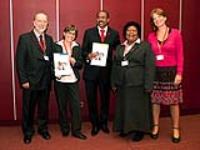
(From L to R) Mark Richmond, UNESCO’s Global Coordinator on HIV and AIDS, Dr Mariangela Batista Galvao Simao, Director, Brazil National STD/AIDS Programme, Michel Sidibé, UNAIDS Executive Director, Elizabeth Mataka, member of the Global Advisory Group on Sexuality Education and the UN Secretary-General’s Special Envoy for AIDS in Africa and Marijke Wijnroks, the AIDS ambassador for the Netherlands
Credit: UNAIDS/D.Bregnard
In many parts of the world, a combination of social taboos, unavailability of sound information, lack of resources and infrastructure make it difficult for children and young people to access sexuality education aimed at improving knowledge and reducing risk. This leaves many young people vulnerable to coercion, abuse, exploitation, unintended pregnancy and sexually transmitted infections, including HIV.
According to the UNAIDS 2008 Global Report on the AIDS Epidemic, only 40% of young people aged 15-24 had accurate knowledge about HIV and transmission. It should come as no surprise that, against this background of insufficient levels of basic knowledge, young people aged 15-24 account for 40% of all new HIV infections (UNAIDS 2009 AIDS Epidemic Update).
In response to this challenge, the voluntary and non-mandatory International Technical Guidance on Sexuality Education developed by UNESCO in partnership with UNAIDS, UNFPA, UNICEF and WHO seeks to assist education, health and other relevant authorities to develop and implement school-based sexuality education materials and programmes. The International Technical Guidance on Sexuality Education is based on a rigorous review of evidence on sexuality education programmes and is aimed at education and health sector decision-makers and professionals.
If we are to make an impact on children and young people before they become sexually active, comprehensive sexuality education must become part of the formal school curriculum, delivered by well trained and supported teachers.
Michel Sidibé, UNIADS Executive Director
Sexuality education can play a key role in improving knowledge and reducing sexual risk behaviours among young people. Equipped with better knowledge, information and skills, young people can be empowered to make informed decisions about sexual choices.
“If we are to make an impact on children and young people before they become sexually active, comprehensive sexuality education must become part of the formal school curriculum, delivered by well trained and supported teachers,” says Michel Sidibé, UNAIDS Executive Director. “Teachers remain trusted sources of knowledge and skills in all education systems and they are a highly valued resource in the education sector response to AIDS.”
The International Technical Guidance on Sexuality Education was co-authored by leading experts in the field of sexuality education and subjected to extensive review and comment by a global panel of experts and practitioners from civil society organizations, ministries of education and international agencies. Volume I of the International Technical Guidance on Sexuality Education focuses on the rationale for sexuality education and provides sound technical advice on characteristics of effective programmes. It is the outcome of a rigorous review of the literature on the impact of sexuality education and sexual behaviour, drawing upon 87 studies from around the world.
Numerous studies show that with the right information and skills, young people can change their behaviour to reduce the risk of acquiring HIV infection or passing it on to others.
Mark Richmond, UNESCO’s Global Coordinator on HIV and AIDS
A companion document (Volume II) focuses on the topics and learning objectives to be covered in a ‘basic minimum package’ on sexuality education for children and young people from 5 to 18+ years of age and includes a bibliography of useful resources. It was informed by a review of curricula from 12 countries, as well as other international models.
“Numerous studies show that with the right information and skills, young people can change their behaviour to reduce the risk of acquiring HIV infection or passing it on to others,” says Mark Richmond, UNESCO’s Global Coordinator on HIV and AIDS and the Director for the Division for the Coordination of UN Priorities in Education. “At a minimum, HIV and AIDS education needs to include information on the HIV virus and its modes of transmission. At some point, HIV and AIDS education must introduce sex and relationships education - simply because over 75% of all HIV infections occur through sexual transmission.”
The UN organizations called on policy-makers to listen to young people, families, teachers and other practitioners, and use the International Technical Guidance to make sexuality education an integral part of the national response to the HIV pandemic.
UNESCO and its partners including UNAIDS, UNFPA, UNICEF and WHO, as well as a wide range of other partners, will support governments in operationalising the International Technical Guidance on Sexuality Education at regional and country level. The two volumes of the International Technical Guidance will be published in all the six UN languages (Arabic, Chinese, English, French, Russian and Spanish) as well as Portuguese.
Sexuality education an imperative for children an
Key populations:
Cosponsors:
Feature stories:
Michel Sidibé calls for prevention revolution in opening address at UNAIDS’ governing body meeting (08 December 2009)
Preventing HIV through education in Latin America and Caribbean (31 July 2009)
New publication champions a strategic approach to HIV and education (15 June 2009)
Publications:
International Technical Guidance on Sexuality Education (Volume-I) (pdf, 2.84 Mb.)
International Technical Guidance on Sexuality Education (Volume-II) (pdf, 1.94 Mb.)

Feature Story
Cricket stars raise awareness about HIV in South Africa
26 October 2009
26 October 2009 26 October 2009
Lasith Malinga, a star player on the Sri Lanka Champions Trophy cricket team, gives a mini-bowling clinic to a group of children in the UNICEF-supported ECHO adolescent development programme in Katlehong Township, South Africa Credit: UNICEF South Africa/2009/Ingham-Brown
Famous Sri Lankan cricketers Kumar Sangakkara, Angelo Mathews, Chamara Kapugedera and Lasith Malinga recently visited young people living with HIV at the WITSECHO Adolescent Sprint Holiday Programme near Johannesburg, South Africa.
The visit took place at the Katlehong Art Centre. It was organised in collaboration with ECHO – a local UNICEF partner that helps provide antiretroviral therapy for some 10,000 South African children – and with the THINK WISE global partnership between the International Cricket Council (ICC), UNAIDS, UNICEF and the Global Media AIDS Initiative.
The THINK WISE partnership works to educate cricket players, coaches, commentators, broadcasters, volunteers and spectators about the AIDS epidemic and HIV prevention.
Raising awareness
THINK WISE is a pioneering partnership which brings anti-AIDS messages home in innovative ways and its ambassadors are doing a great job.
Catherine Sozi, UNAIDS country coordinator for South Africa
Following a spirited fielding session, the cricketers heard from the staff and young people at the youth programme about the work it does to help adolescents develop life skills. The programme trains peer educators to encourage HIV prevention by building the self-esteem and confidence of other young people – and thereby help them make responsible choices.
Most of the children in attendance had contracted HIV from their mothers, who either did not know that they were HIV-positive when they were pregnant or did not have access to treatment that could have prevented them from transmitting the virus to their children.
“It is fantastic to be here today to see firsthand the work that local partners carry out to tackle HIV,” Mr. Sangakkara said, speaking as an ambassador of THINK WISE and the cricketing community. “The work that this programme does has a real impact on the life of these young people and gives me great hope,” he added.
Protection, respect and fairness
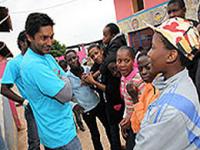 Sri Lanka captain Kumar Sangakkara chats with children in Katlehong Township
Sri Lanka captain Kumar Sangakkara chats with children in Katlehong Township Credit: UNICEF South Africa/2009/Ingham-Brown
“I hope that young people living with HIV can grow up without discrimination and can lead fruitful lives,” said Mr. Mathews. “The young people I have met today are an inspiration, and I hope more people across the world will be able to make informed decisions as they grow up.”
The goals of THINK WISE include encouraging youths to protect themselves and others, and to show respect and fairness to people living with HIV.
“Protection, respect and fairness – these are all values which cricketers easily relate to in our own sport,” said Mr. Malinga.
Catherine Sozi, UNAIDS country coordinator for South Africa, welcomed the visit. “We really appreciated the cricketers taking time to meet young people living with HIV and helping to raise awareness about key issues such as prevention and stigma and discrimination. THINK WISE is a pioneering partnership which brings anti-AIDS messages home in innovative ways and its ambassadors are doing a great job.”
South Africa bears a heavy AIDS burden with an estimated 5.7 million people living with HIV, some 280,000 of whom are children under the age of 15. There are also around 1.4 million children under 17 who have been orphaned due to AIDS.
Cricket stars raise awareness about HIV in South
Cosponsors:
Partners:
Unite for Children, Unite against AIDS
International Cricket Council (ICC): THINK WISE
Global Media AIDS Initiative
Multimedia:
Feature stories:
United for UNICEF: Manchester United visit highlights HIV and rights of vulnerable children (27 August 2009)
Peer educators raising HIV awareness through sport in Trinidad and Tobago (03 June 2009)
UNICEF working to teach AIDS prevention to young people in Guinea (16 April 2009)
UNICEF: Communities provide a bigger ‘family’ for orphaned children in Rwanda (09 March 2009)
Third stocktaking report on children and AIDS (01 December 2008)
Publications:
Children and AIDS: Third stocktaking report, 2008 (pdf, 1.90 Mb.)
Children and AIDS: Third stocktaking report, 2008, Summary (pdf, 2.71 Mb.)

Feature Story
Governments and civil society expand access to HIV testing and counselling
30 September 2009
30 September 2009 30 September 2009This story has also been published at www.who.int/hiv

Photo credit: WHO
A brightly coloured van known as the ‘Tutu Tester’ has become a familiar sight in Cape Town, South Africa, as part of an accelerating drive to persuade people to know their HIV status. More than 10 000 people have been tested and counselled since May 2008 when the mobile clinic from the Desmond Tutu HIV Foundation took to the road.
It is one of many initiatives in sub-Saharan Africa designed to dispel the stigma and fear long associated with AIDS through imaginative campaigns ranging from sex worker advice at truck stops to peer counselling in mining areas to national testing weeks spearheaded by celebrities. The campaigns are part of wider national and international efforts to expand the number of people receiving testing and counselling—which is often referred to as ‘the gateway to HIV prevention, treatment and care’ because it is a precondition for timely access to all three, including antiretroviral therapy which cuts mortality rates.
Ninety percent of low- and middle-income countries last year reported that they have national HIV testing and counselling polices, up from 70% in 2007, according to the 2009 Towards universal access progress report, published by WHO, UNICEF and UNAIDS. Countries hardest hit by the pandemic—Botswana, Kenya, Lesotho, Malawi, Namibia, Rwanda, South Africa, Swaziland, Tanzania and Uganda—are testing and counselling pregnant mothers as the basis for prevention of mother-to-child transmission (PMTCT) to cut the number of infants born with HIV, and to help HIV-negative pregnant women stay negative.
There is encouraging evidence that more countries are adhering to WHO-UNAIDS guidance on provider-initiated testing and counselling in health facilities. This recommends HIV testing and counselling as part of the standard care to all persons with symptoms or medical conditions that could indicate HIV infection, to infants born to HIV-positive women, and in generalized epidemics to all persons attending health facilities. The guidelines are key to facilitating early diagnosis in countries which are struggling with a dual HIV-TB epidemic.
The number of health centres providing HIV testing and counselling is on the increase. In 15 reporting nations in East, South and South-East Asia, the number of such facilities rose from 13 000 to 15 000 between 2007 and 2008; in reporting Latin American and Caribbean countries it doubled, while sub-Saharan Africa boasted a 50% increase.
Some countries have made more progress than others. Ethiopia increased its number of facilities from 1005 to 1469 and reported that 4.5 million people received testing and counselling in 2008, up from 1.9 million in 2007. At the other end of the scale, less than 10% of health centres in Nigeria and the Democratic Republic of Congo had testing and counselling facilities.
Cameroon adopted provider-initiated testing and counselling in 2007. This was part of the government commitment to increase the number of people on treatment, up from 600 in 2001 to 60 000 in November 2008, according to WHO’s National Programme Officer for HIV/AIDS in Cameroon, Etienne Kembou. Although much remains to be done to train health professionals to implement the government model at local level, Kembou says about 85% of pregnant women at health facilities agree to be tested, as do growing numbers of men. “AIDS is not stigmatised like it was in the 1990s and many people who are HIV-positive are open about it,” Kembou says, adding that the annual national testing week and peer education projects aimed at 15–25 year-olds have helped enormously.
Uganda and Kenya have expanded coverage through home-based testing and counselling, whereby trained counsellors go from door to door. The advantage is that couples can be counselled together in a familiar environment without the stigma of going into a government facility. As a result, there are fewer disclosure problems which may arise with the male or female partner testing separately. It means that undiagnosed children with the virus can access HIV services and that high-risk areas such as the Kibera slum near Nairobi can be targeted.
In nations like Botswana and Swaziland, the government drive to scale up male circumcision for HIV prevention has led to an upsurge in testing and counselling among males, an often underserved group, as a precondition for the surgical intervention. WHO’s country representative in Botswana, Eugene Nyarko, says intensified prevention campaigns targeting youth are bearing fruit. “Across the board there is an increase in testing because young people know they can benefit from interventions if they know their status.”
In South Africa, which has the highest number of people in the world living with HIV, a national population-based survey in 2008 by the Human Sciences Research Council showed that 50% of respondents over 15 years of age said they had received an HIV test, compared to 20% in 2002. Between 2005 and 2008, the percentage of women and men who reported having an HIV test in the past 12 months more than doubled.
Civil society groups in South Africa, like the Treatment Action Campaign, have mounted high profile ‘Get Tested’ campaigns. There are many local initiatives backed by foreign donor funding and the government, and the message is getting through.
Sweetness Mzoli, runs an organisation called Kwakhanya (‘Light’) which helps care for 300 beneficiaries in Khayelitsha, a poor suburb of Cape Town with high HIV prevalence. She tours minibus taxi ranks trying to persuade men to be tested and counselled and notes there is far less resistance than even a year ago. “It’s coming right. There’s a lot of men out there who want to talk about their status and who want to know their status,” she comments.
The ‘Tutu Tester’ is also a regular visitor to Khayelitsha’s taxi ranks, as well as to shopping malls and other crowded areas. The testing and counselling process is efficient, thorough and friendly. Clients can avoid lengthy queues at public health facilities, while knowing they will receive high quality, confidential service.
“When you make it quick and efficient, people are willing to undergo testing,” says project coordinator Nienke van Schaik. The mobile clinic now offers a package, including testing for hypertension and diabetes “to make it less scary,” she says. “We literally just pitch up. People see us and run off and fetch their partners and family members. People are willing to test.”
Governments and civil society expand access to HI
Cosponsors:
World Health Organization (WHO)
United Nations Children’s Fund (UNICEF)
Publications:
Towards Universal Access: Scaling Up Priority HIV/AIDS Interventions in the Health Sector (pdf, 3 Mb.)
UNAIDS Outcome Framework 2009-2011 (pdf, 388 Kb.)

Feature Story
More than four million HIV-positive people now receiving life-saving treatment
30 September 2009
30 September 2009 30 September 2009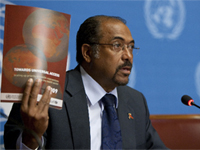
UNAIDS Executive Director presents the new WHO/UNAIDS/UNICEF report at the UN in Geneva, 30 September 2009. Credit: WHO/Christopher Black
Geneva / Paris -- More than 4 million people in low- and middle-income countries were receiving antiretroviral therapy (ART) at the close of 2008, representing a 36% increase in one year and a ten-fold increase over five years, according to a new report released today by the World Health Organization (WHO), the United Nations Children's Fund (UNICEF) and the Joint United Nations Programme on HIV/AIDS (UNAIDS).
Towards Universal Access: Scaling Up Priority HIV/AIDS Interventions in the Health Sector highlights other gains, including expanded HIV testing and counselling and improved access to services to prevent HIV transmission from mother to child.
"This report shows tremendous progress in the global HIV/AIDS response," said WHO Director-General Margaret Chan. "But we need to do more. At least 5 million people living with HIV still do not have access to life-prolonging treatment and care. Prevention services fail to reach many in need. Governments and international partners must accelerate their efforts to achieve universal access to treatment."
Treatment and Care
Access to antiretroviral therapy continues to expand at a rapid rate. Of the estimated 9.5 million people in need of treatment in 2008 in low- and middle-income countries, 42% had access, up from 33% in 2007. The greatest progress was seen in sub-Saharan Africa, where two-thirds of all HIV infections occur.

Prices of the most commonly used antiretroviral drugs have declined significantly in recent years, contributing to wider availability of treatment. The cost of most first-line regimens decreased by 10-40% between 2006 and 2008. However, second-line regimens continue to be expensive.
Despite recent progress, access to treatment services is falling far short of need and the global economic crisis has raised concerns about their sustainability. Many patients are being diagnosed at a late stage of disease progression resulting in delayed initiation of ART and high rates of mortality in the first year of treatment.
Testing and Counselling
Recent data indicate increasing availability of HIV testing and counselling services. In 66 reporting countries, the number of health facilities providing such services increased by about 35% between 2007 and 2008.
Testing and counselling services are also being used by an increasing number of people. In 39 countries, the total reported number of HIV tests performed more than doubled between 2007 and 2008.
Ninety-three percent of all countries that reported data across all regions provided free HIV testing through public sector health facilities in 2008.
Nevertheless, the majority of those living with HIV remain unaware of their HIV status. Low awareness of personal risk of HIV infection and fear of stigma and discrimination account, in part, for low uptake of testing services.
Women and Children
In 2008, access to HIV services for women and children improved. Approximately 45% of HIV-positive pregnant women received antiretroviral drugs to prevent HIV transmission to their children, up from 35% in 2007. Some 21% of pregnant women in low- and middle-income countries received an HIV test, up from 15% in 2007.
More children are benefiting from paediatric antiretroviral therapy programmes: the number of children under 15 years of age who received ART rose from approximately 198 000 in 2007 to 275 700 in 2008, reaching 38% of those in need.
Globally, AIDS remains the leading cause of mortality among women of reproductive age.
"Although there is increasing emphasis on women and children in the global HIV/AIDS response, the disease continues to have a devastating impact on their health, livelihood and survival," said Ann M. Veneman, UNICEF Executive Director.
Most-At-Risk Populations
In 2008, more data became available on access to HIV services for populations at high risk of HIV infection, including sex workers, men who have sex with men and injecting drug users.
While HIV interventions are expanding in some settings, population groups at high risk of HIV infection continue to face technical, legal and sociocultural barriers in accessing health care services.
"All indications point to the number of people needing treatment rising dramatically over the next few years," said Michel Sidibé, Executive Director of UNAIDS. "Ensuring equitable access will be one of our primary concerns and UNAIDS will continue to act as a voice for the voiceless, ensuring that marginalized groups and people most vulnerable to HIV infection have access to the services that are so vital to their wellbeing and to that of their families and communities."
More than four million HIV-positive people now re
Cosponsors
Press centre:
Download printable version (pdf, 40 Kb.)
Feature stories:
Governments and civil society expand access to HIV testing and counselling (30 September 2009)
More infants protected from HIV as access to antiretroviral drugs to prevent mother-to-child transmission increases (30 September 2009)
Contact:
In Geneva:
WHO
Saira Stewart
T: +41 22 791 2511
M: +41 79 467 2013
E: stewarts@who.int
UNAIDS
Sophie Barton-Knott
T: +41 22 791 1697
M: +41 79 514 6896
E: bartonknotts@unaids.org
In New York:
UNICEF
Kathryn Donovan
T: + 1 212 326 7452
E: kdonovan@unicef.org
In London:
Cathy Bartley
T: +44 20 8694 9138
M: +44 7958 561 671
E: cathy.bartley@bartley-robbs.co.uk
Claire Hoffman
T: +44 208 892 5215
M: +44 7977 440 353
E: claire.hoffman@bartley-robbs.co.uk
In Paris:
Michel Aublanc
T:+33 1 69 286 286
M: +33 6 08 719 795
E: michel.aublanc@orange.fr
Related

Feature Story
UNAIDS partners in new Clinton Global Initiative to address sexual violence against girls
25 September 2009
25 September 2009 25 September 2009
UNAIDS and cosponsors UNICEF, UNFPA and WHO have joined the Centers for Disease Control and Prevention, UNIFEM and private sector supporters through the Clinton Global Initiative to address the injustices and health impact of sexual violence against girls. The initiative, launched in New York by the partners, will focus on countries where sexual violence is a key initiation point for the spread of HIV and other infectious diseases.
Partners of the initiative will come together to conduct research in seven countries using the methodology piloted in Swaziland in 2007 by UNICEF and the Centers for Disease Control and Prevention (CDC).
In collaboration with World Health Organization, UNICEF and CDC will use the survey results to develop a technical package of policy and social interventions, tailored individually for the countries in southern Africa, Asia and the Pacific regions.
“While it is generally known that sexual violence against girls is a global problem, very limited data exist on the extent of this problem in the developing world. Obtaining valid data is a key step toward mobilizing policy and other positive interventions,” said Dr. Rodney Hammond, Director of the Division of Violence Prevention in CDC’s Injury Center.
“Sexual violence against children is a gross violation of their rights, a moral and ethical outrage and an assault on the world’s conscience,” said Ann M. Veneman, Executive Director of UNICEF. “Sexual abuse can lead to lost childhoods, abandoned education, physical and emotional problems, the spread of HIV, and an often irrevocable loss of dignity and self-esteem.”
“Sexual violence against girls increases their vulnerability to HIV infection and must be stopped,” said Michel Sidibé, UNAIDS, Executive Director. “AIDS responses must include programmes to stop sexual violence as an integral part of HIV prevention and treatment programmes.”
2007 Swaziland survey
In 2007 CDC, UNICEF and several local institutions partnered to implement a national survey on violence against girls and young women in Swaziland. Swaziland has the highest prevalence of HIV among adults globally. The survey showed that approximately one-third of girls had a history of sexual violence.
This survey led to a series of policy and legislative interventions in the country, including establishment of the nation’s first Sexual Offenses Unit for children, and a push for legislation against domestic violence and sexual offences.
According to WHO, in 2002 approximately 150 million girls experienced some form of sexual violence. Research demonstrates that violence occurring early in life affects neurological and cognitive functioning, and triggers multiple negative impacts, including sexual disease transmission, drug and alcohol abuse and psychological distress.
Stopping violence against women and girls
The Centers for Disease Control and Prevention (CDC) and UNICEF are the lead organizations in new this initiative, with partners including the CDC Foundation, the Nduna Foundation, Grupo ABC, WHO, UNAIDS, UNFPA and UNIFEM.
Stopping violence against women and girls is one of the nine priority areas of UNAIDS as described in the UNAIDS Outcome Framework (2009-2011). UNAIDS with its cosponsors will leverage the AIDS response as an opportunity to reduce sexual violence and support the initiative partners’ efforts to develop comprehensive responses to sexual violence and HIV prevention and treatment within and beyond the health sector. UNAIDS will provide funding to support this issue.
Clinton Global Initiative
The Clinton Global Initiative (CGI) has served as the central convening body for bringing together the lead organizations and key partners. CGI venues served as the critical link for engaging new partners and it has also served as the key forum for the steering committee overseeing this effort, and as a mobilizing force for raising public awareness and leadership commitment.
UNAIDS Executive Director Michel Sidibé has been in New York this week for a series of events and meetings.
UNAIDS partners in new Clinton Global Initiative
Cosponsors:
Press centre:
Concerted Action Required to Address the Twin Epidemics of Violence Against Women and AIDS (30 November 2009)
Women on the frontlines of the AIDS response (08 March 2004)
Feature stories:
Highlighting sexual violence on International Women’s Day (05 March 2009)
Challenging violence against women a key task for newly launched Caribbean Coalition on Women, Girls and AIDS (06 march 2009)
External links:
Centres for Disease Control and Prevention
UNIFEM
Clinton Global Initiative
Publications:
Stop violence against women. Fight AIDS (pdf, 126 Kb.)
Violence against Women and Girls in the Era of HIV and AIDS (pdf, 944 Kb.)
Related

Feature Story
Bruni-Sarkozy endorses UNAIDS call to virtually eliminate mother-to-child HIV transmission by 2015
23 September 2009
23 September 2009 23 September 2009
(from left) Nicolas Sarkozy President of France; Carla Bruni-Sarkozy, First Lady of France and Global fund Ambassador for the Protection of Mothers and Children against HIV/AIDS; Executive Director of the Global Fund, Michel Kazatchkine; Michel Sidibé, Executive Director of UNAIDS. Credit: UNAIDS/B. Hamilton
Carla Bruni-Sarkozy echoed UNAIDS call to virtually eliminate mother-to-child HIV transmission by 2015 while addressing the UN Secretary General Ban Ki-moon and leaders at a side event to the opening of the United Nations General Assembly in New York. The President of Burkina Faso Mr Blaise Compaoré and the Prime Minister of Ethiopia Mr Meles Zenawi co-chaired the event.
Isn’t it an immense injustice, that thousands of children still are born with HIV, when treatment exists, when no baby needs to be born with HIV?
Carla Bruni-Sarkozy, First Lady of France and the Global Fund’s Ambassador for the protection of mothers and children against AIDS
“Around the world only a third of women living with HIV receive the necessary treatment to prevent the transmission. Isn’t it an immense injustice, that thousands of children still are born with HIV, when treatment exists, when no baby needs to be born with HIV?” asked the First Lady of France and the Global Fund’s Ambassador for the protection of mothers and children against AIDS. Ms Bruni-Sarkozy called on global leaders to double the number of HIV-positive pregnant women who receive effective antiretroviral treatment within 18 months.
UN Secretary-General Ban Ki-moon called for a more ambitious approach: “We have effective drugs. There is no reason why any mother should die of AIDS. There is no cause for any child to be born with HIV,” he said. “If we work hard enough we can virtually eliminate mother-to-child transmission.”
 (Front row of panel from left): Christina Rodriguez, community member; Carla Bruni-Sarkozy, First Lady of France and the Global Fund’s Ambassador for the protection of mothers and children against AIDS, UN Secretary-General Ban Ki-moon
(Front row of panel from left): Christina Rodriguez, community member; Carla Bruni-Sarkozy, First Lady of France and the Global Fund’s Ambassador for the protection of mothers and children against AIDS, UN Secretary-General Ban Ki-moon Credit: UNAIDS/B. Hamilton
Community member Christina Rodriguez, 17 years-old, from New York called for access to services for young people, and shared a moving personal testimony from Keren Gonzalez, 13 years-old, from Honduras, who could not attend the meeting. Morolake Odetoyinbo from Nigeria highlighted the importance of provinding treatment, care and support for mothers living with HIV so that they can stay alive and take care of their children, and called for urgent leadership to deliver on this life-saving commitment.
Other leaders participated in the event including President Sarkozy of France, President Abdoulaye Wade of Senegal, Prime Minister Balkenende of the Netherlands, as well as First Ladies of several countries.
Countries will work with the Global Fund, UNAIDS and UNICEF support to ensure rapid scale-up of programmes to prevent transmission of HIV from mothers to children. The Global Fund will support the switch from single-dose Nevirapine to more effective dual and triple therapy regimens in the next 18 months. More emphasis and funds will be applied to comprehensive programmes addressing reproductive health and the strengthening of maternal and child health services.
Executive Director Michel Sidibé UNAIDS has made the prevention of mothers from dying and babies from becoming infected with HIV a priority and it is one of the nine priority areas in the UNAIDS Outcome Framework 2009-2011.
Bruni-Sarkozy endorses UNAIDS call to virtually e
Cosponsors:
Partners:
The Global Fund to Fight AIDS, TB and Malaria
Feature stories:
UNAIDS/Millennium Villages Project join forces to keep babies free from HIV in Africa (21 September 2009)
Deputy President of South Africa echoes UNAIDS priorities at international AIDS conference (20 july 2009)
Lesotho: HIV free babies bring hope (16 July 2009)
Press centre:
UNAIDS/Millennium Villages Project join forces to keep babies free from HIV in Africa (21 September 2009)
UNAIDS calls for a virtual elimination of mother to child transmission of HIV by 2015 (21 May 2009)
Statements:
Remarks by UN Secretary-General Ban Ki-moon at "A call to action: Protecting mothers and children against AIDS" United Nations, New York, Wednesday 23 September.
Speech by Carla Bruni-Sarkozy "A call to action: Protecting mothers and children against AIDS". United Nations, New York, Wednesday 23 September.
Statement from Keren Dunaway Gonzalez, 13 years old, Honduras. Read by Christina Rodriguez in New York, 23 September 2009.
Publications:
Joint action for results: UNAIDS outcome framework, 2009 – 2011 (pdf, 432 Kb.)

